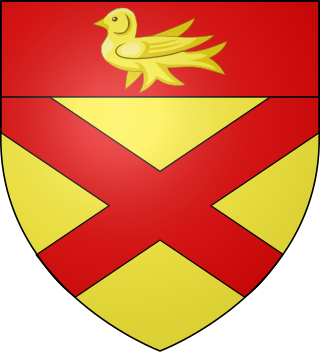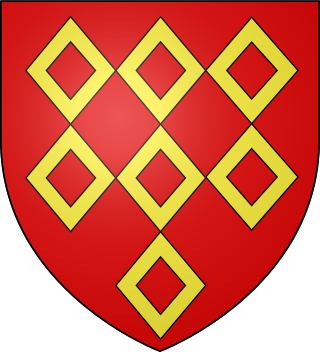
Baron Aberdare, of Duffryn in the County of Glamorgan, is a title in the Peerage of the United Kingdom. It was created on 23 August 1873 for the Liberal politician Henry Bruce. He served as Home Secretary from 1868 to 1873. His grandson, the third Baron, was a soldier, cricketer and tennis player and a member of the International Olympic Committee. His son, the fourth Baron, held office in the Conservative administration of Edward Heath and was later a Deputy Speaker of the House of Lords. Lord Aberdare was one of the ninety-two elected hereditary peers that were allowed to remain in the House of Lords after the passing of the House of Lords Act 1999. As of 2017 the title is held by his son, the fifth Baron, who succeeded in 2005 and was elected to the House of Lords in 2009.
Lord of Abercrombie was a title in the Peerage of Scotland that was created on 12 December 1647. It became extinct on the death of the 2nd Lord in 1681.
Baron Allerton, of Chapel Allerton in the West Riding of the County of Yorkshire, was a title in the Peerage of the United Kingdom. It was created on 17 July 1902 for the businessman and Conservative politician William Jackson. The title became extinct on the death of his grandson, the third Baron, on 1 July 1991.
Roger de Montgomery, also known as Roger the Great, was the first Earl of Shrewsbury, and Earl of Arundel, in Sussex. His father was Roger de Montgomery, seigneur of Montgomery, a member of the House of Montgomery, and was probably a grandnephew of the Duchess Gunnor, wife of Duke Richard I of Normandy, the great-grandfather of William the Conqueror. The elder Roger had large landholdings in central Normandy, chiefly in the valley of the River Dives, which the younger Roger inherited.
Gilbert Fitz Richard, 2nd feudal baron of Clare in Suffolk, and styled "de Tonbridge", was a powerful Anglo-Norman baron who was granted the Lordship of Cardigan, in Wales c. 1107–1111.

John Egerton, 3rd Earl of Bridgewater KB PC was a British nobleman from the Egerton family.
Baron Boteler was a title that was created three times in the Peerage of England.

Edward Brooke, 6th Baron Cobham, lord of the Manor of Cobham, Kent, was an English peer.

Stephen of Aumale was Count of Aumale from before 1089 to 1127, and Lord of Holderness.
Margaret de Audley,suo jure2nd Baroness Audley and Countess of Stafford was an English noblewoman. She was the only daughter of Hugh de Audley, 1st Earl of Gloucester, by his wife Lady Margaret de Clare. Her mother was the daughter of Joan of Acre, Princess of England; thus making Margaret a great-granddaughter of King Edward I by his first consort, Eleanor of Castile. As the only daughter and heiress of her father, she succeeded to the title of 2nd Baroness Audley [E., 1317] on 10 November 1347.
Robert de Ferrers, 3rd Baron Ferrers of Chartley, was the son of John de Ferrers, 1st Baron Ferrers of Chartley and Hawise de Muscegros, a daughter of Robert de Muscegros.

Thomas Burgh, 3rd Baron Burgh KG 3rd Baron Borough of Gainsborough, de jure7th Baron Strabolgi and 9th Baron Cobham of Sterborough was the son of William Burgh, 2nd Baron Burgh and Lady Katherine Clinton, daughter of Edward Clinton, 1st Earl of Lincoln and Elizabeth Blount, former mistress of King Henry VIII. He was one of the peers who conducted the trial of the Duke of Norfolk in 1572.

Wingfield Cromwell, 2nd Earl of Ardglass, DCL, was an English nobleman, son of Thomas Cromwell, 1st Earl of Ardglass and Elizabeth Meverell. He held the subsidiary titles of 2nd Viscount Lecale and 5th Baron Cromwell of Oakham.

Thomas Cromwell, 3rd Earl of Ardglass, was an English nobleman, the only son of Wingfield Cromwell, 2nd Earl of Ardglass of Ilam, Staffordshire and Mary Russell. He held the subsidiary titles of 3rd Viscount Lecale and 6th Baron Cromwell of Oakham.

Vere Essex Cromwell, 4th Earl of Ardglass PC (I), was an English nobleman, son of Thomas Cromwell, 1st Earl of Ardglass and Elizabeth Meverell. He was the last direct male descendant of Henry VIII's chief minister, and key architect of the English reformation, Thomas Cromwell.
Sir Henry Knollys of Kingsbury, Warwickshire was an English courtier, privateer and Member of Parliament.
Rohese de Clare was a member of the wealthy and powerful de Clare family and a strong patron of Monmouth Priory.

Henry Ferrers, 4th Baron Ferrers of Groby (1356–1388) was a fourteenth-century English nobleman. He was a professional soldier, taking part in a number of campaigns during the reign of Richard II, served on several royal commissions, was a justice of the peace and a member of parliament.

Elizabeth Scott, Duchess of Buccleuch, formerly Lady Elizabeth Montagu, was the wife of Henry Scott, 3rd Duke of Buccleuch.
Anne Lennox, Duchess of Richmond, formerly Anne Brudenell, was the wife of two English noblemen: first, Henry Belasyse, 2nd Baron Belasyse of Worlaby, and second, Charles Lennox, 1st Duke of Richmond. She was the mother of Charles Lennox, 2nd Duke of Richmond.








